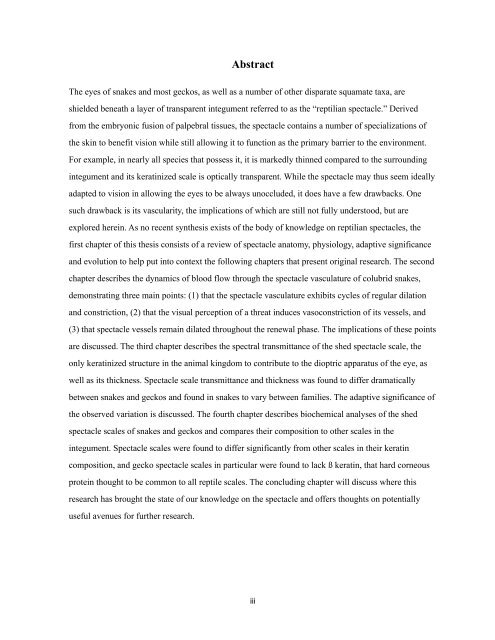Chapter 1, The Reptilian Spectacle - UWSpace - University of ...
Chapter 1, The Reptilian Spectacle - UWSpace - University of ...
Chapter 1, The Reptilian Spectacle - UWSpace - University of ...
Create successful ePaper yourself
Turn your PDF publications into a flip-book with our unique Google optimized e-Paper software.
Abstract<br />
<strong>The</strong> eyes <strong>of</strong> snakes and most geckos, as well as a number <strong>of</strong> other disparate squamate taxa, are<br />
shielded beneath a layer <strong>of</strong> transparent integument referred to as the “reptilian spectacle.” Derived<br />
from the embryonic fusion <strong>of</strong> palpebral tissues, the spectacle contains a number <strong>of</strong> specializations <strong>of</strong><br />
the skin to benefit vision while still allowing it to function as the primary barrier to the environment.<br />
For example, in nearly all species that possess it, it is markedly thinned compared to the surrounding<br />
integument and its keratinized scale is optically transparent. While the spectacle may thus seem ideally<br />
adapted to vision in allowing the eyes to be always unoccluded, it does have a few drawbacks. One<br />
such drawback is its vascularity, the implications <strong>of</strong> which are still not fully understood, but are<br />
explored herein. As no recent synthesis exists <strong>of</strong> the body <strong>of</strong> knowledge on reptilian spectacles, the<br />
first chapter <strong>of</strong> this thesis consists <strong>of</strong> a review <strong>of</strong> spectacle anatomy, physiology, adaptive significance<br />
and evolution to help put into context the following chapters that present original research. <strong>The</strong> second<br />
chapter describes the dynamics <strong>of</strong> blood flow through the spectacle vasculature <strong>of</strong> colubrid snakes,<br />
demonstrating three main points: (1) that the spectacle vasculature exhibits cycles <strong>of</strong> regular dilation<br />
and constriction, (2) that the visual perception <strong>of</strong> a threat induces vasoconstriction <strong>of</strong> its vessels, and<br />
(3) that spectacle vessels remain dilated throughout the renewal phase. <strong>The</strong> implications <strong>of</strong> these points<br />
are discussed. <strong>The</strong> third chapter describes the spectral transmittance <strong>of</strong> the shed spectacle scale, the<br />
only keratinized structure in the animal kingdom to contribute to the dioptric apparatus <strong>of</strong> the eye, as<br />
well as its thickness. <strong>Spectacle</strong> scale transmittance and thickness was found to differ dramatically<br />
between snakes and geckos and found in snakes to vary between families. <strong>The</strong> adaptive significance <strong>of</strong><br />
the observed variation is discussed. <strong>The</strong> fourth chapter describes biochemical analyses <strong>of</strong> the shed<br />
spectacle scales <strong>of</strong> snakes and geckos and compares their composition to other scales in the<br />
integument. <strong>Spectacle</strong> scales were found to differ significantly from other scales in their keratin<br />
composition, and gecko spectacle scales in particular were found to lack ß keratin, that hard corneous<br />
protein thought to be common to all reptile scales. <strong>The</strong> concluding chapter will discuss where this<br />
research has brought the state <strong>of</strong> our knowledge on the spectacle and <strong>of</strong>fers thoughts on potentially<br />
useful avenues for further research.<br />
iii
















